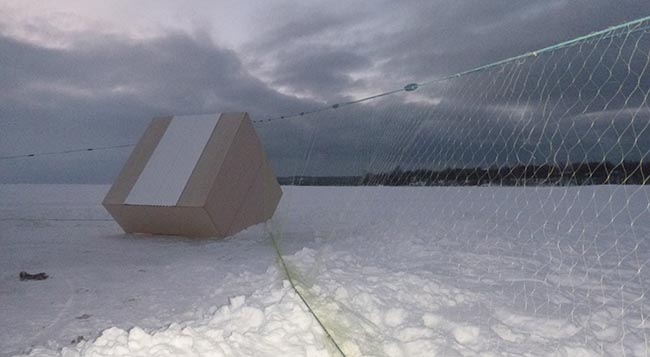The ‘Site Specific’ art and politics of Aylan Couchie

By Catherine Murton Stoehr
NORTH BAY – Nipissing University doesn’t host a lot of speakers who get quoted in the New York Times but last week Nipissing First Nation artist Aylan Couchie treated a group of fine arts students to a master class in the nuts and bolts of what she called “site-specific” public art.
To hear the award-winning artist speak to the students you wouldn’t think she had anything on her mind but using her own experiences to support students developing their craft.
Couchie is an increasingly familiar name in the national discussion on anti-colonialism and reconciliation. Her “counter petition” educating Canadian environmentalists boycotting Toronto’s seal-meat-serving Kukum Kitchen caught the attention of the American media. The Times quoted Couchie saying, “It’s time to stop the cycle of willfully ignorant Canadians who continue to impose their ill-considered values upon indigenous practices and people.” That same sentiment – understanding being critical to right action, and ignorance a poor excuse for error, is a major theme in the artist’s work.
Starting on a practical note, Couchie showed the students “how to” diagrams she had sent to distant galleries where her art would be assembled by other people, saying it’s useful to understand the life cycle of a project. A harsh online comment demonstrated that public artists must anticipate and prepare themselves for hostility. She talked about abandoning a triangular copper “roof” that had been a full week in the making because the piece was finished without it. And a story about repurposing a statue of a little girl smoking into a gift for her mother by swapping out the cigarette for flowers offered one solution to the “storage” problem posed by large-scale art.
North Bay’s biannual Ice Follies show, in which artists from around the world build works to be displayed on frozen Lake Nipissing, was the occasion for the artists’ visit. She shared with the students her disappointment about an installation in Ice Follies 2016 by artist Jihee Min.
Critical of over fishing, Min’s “A Humble Trawling” focused on netting, an Anishinabe practice. This was a “massive oversight,” according to Couchie. Most local people could have told the Toronto artist that non-indigenous line fishing accounts for most extraction today. An acrimonious conflict between the two kinds of fishers has dominated local discussions of conservation for years. Couchie’s 2018 response, now is the time to see the truth, is a stylized ice hut pushing a fishing net to the point of strain – a physical representation of the tension between the two communities.
Now is the time to see the truth “looks to illustrate this ongoing tension,” she explained, “which continues to disrupt the process of reconciliation and serves as a reminder that in these precarious times of changing climate and destructive pollution of our waterways, we are all stewards of these lands.”
“Know the history, do the research” she urged the students. “Any installation needs to come from a good place and be well thought-out.”
All of Couchie’s work shows a deep understanding of the historical origins of modern indigenous realities produced by settler colonialism. She took a year off from making art and read about the Indian Act, the TRC, the treaties, and the 60s scoop “as much as I could to inform myself.” “I saw things happening in Canada now I could tie to 100 year old policies.”
In a vindication of Oscar Wilde’s observation that life imitates art, the artist found herself thrust into the tension between Nipissing First Nation and North Bay, between First Nations and colonial Canada, that very night. The Gerald Stanley verdict came down “not guilty” and Couchie worked with Nipissing First Nation Chief Scott McLeod to organize a vigil that brought nearly 100 members of Nipissing First Nation and the North Bay community together to mourn the injustice done to Colten Boushie, and so many others.
Asked about why she thinks so many people are responding to her work Couchie said “I’m baffled, I don’t know.” But the almost mathematical coherence of her work, intervention, and method provides a clue.
Right action must be “site specific.” Thus her laser focus on the needs of students when her role is senior artist. Her knowledge of local history enabled a precise intervention to correct a community’s understanding of Lake Nipissing warped by “A Humble Trawling.” And when national politics touched down with the Stanley verdict her site specific knowledge of the nation’s history enabled her to take up the work of ensuring that her own community, Nipissing First Nation, participated in the spontaneous national broadcast of grief and outrage at the injustice done to the Boushie family.
If Aylan Couchie thinks now is the time to see the truth, it may well be.


